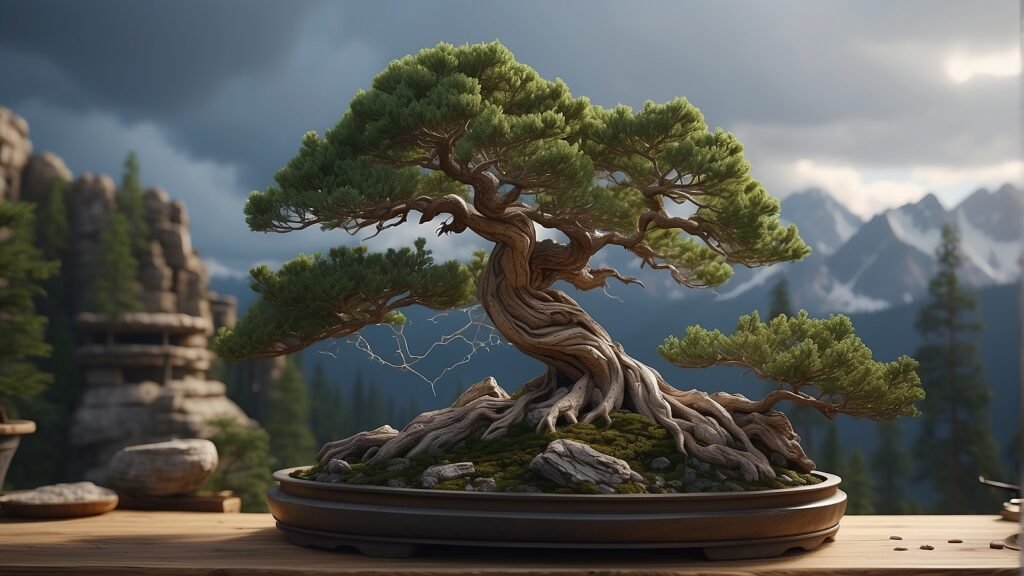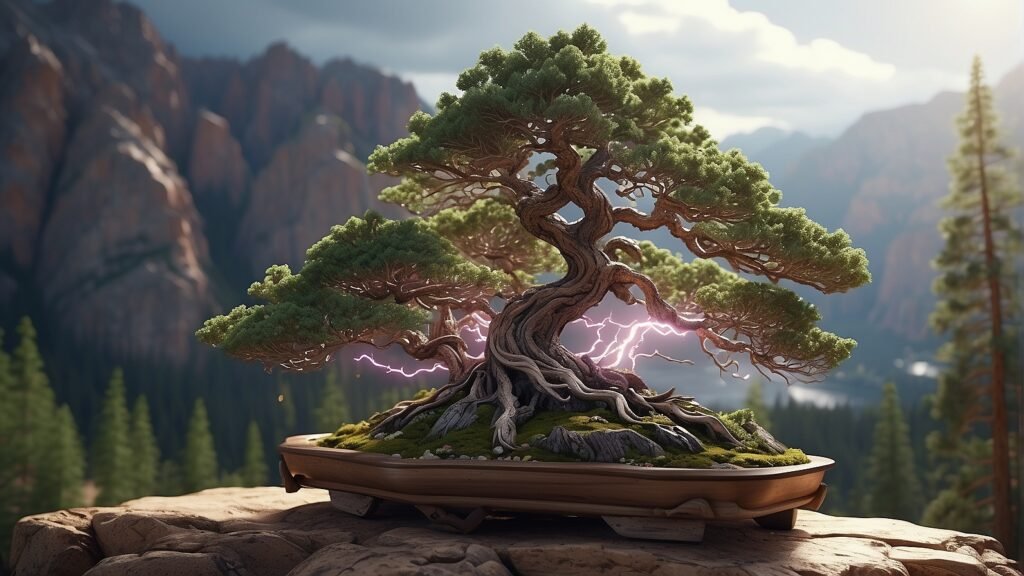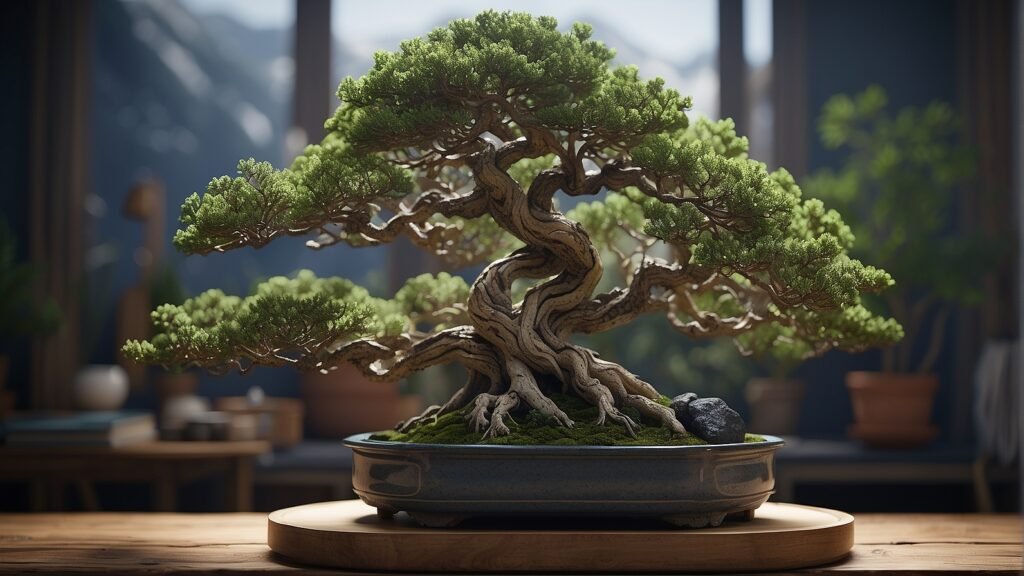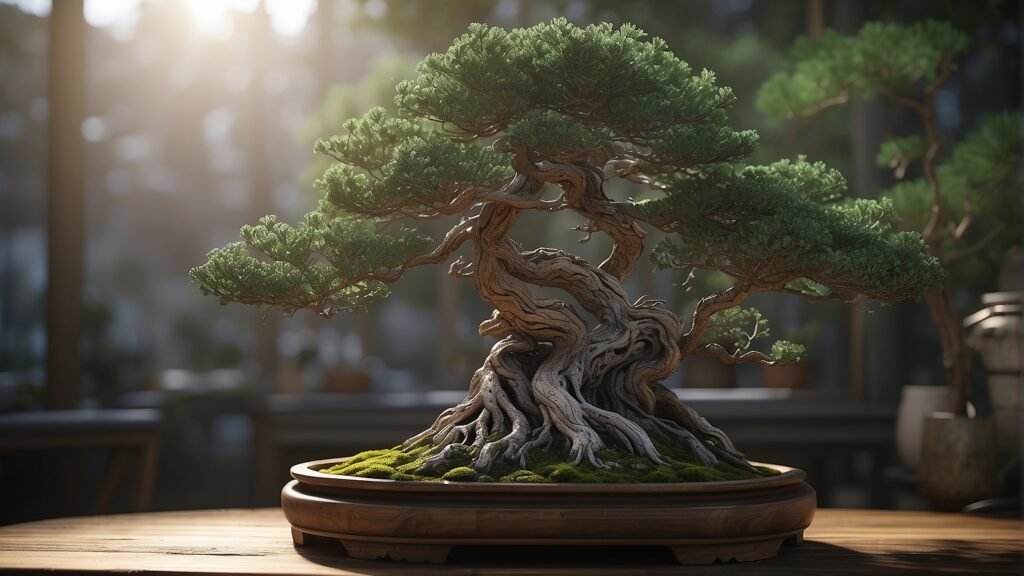Imagine having a miniature mountain landscape right on your coffee table. Sounds incredible, doesn’t it? Well, that’s exactly what a Rocky Mountain Pine Bonsai is – a tiny slice of the rugged Rockies you can enjoy in your cozy living room. This bonsai is a small replica of the mighty Rocky Mountain Pines that dominate the mountainous landscapes of western North America. It’s a beautiful sight, with its thick bark and clusters of needles. So, grab a cup of tea, sit back, and let’s explore this amazing little tree together.
The Rocky Mountain Pine Bonsai: A Star in the Bonsai Universe
Now, why do people go gaga over this particular bonsai species? Here’s why:

- Unique Beauty: With its thick, scaly bark and dense needle clusters, it’s a real eye-catcher.
- Exciting Challenge: For many enthusiasts, the thrill lies in taming this high-altitude dweller into a bonsai form. It’s like a puzzle waiting to be solved.
- Popularity: Its popularity isn’t just confined to the Rockies. This bonsai species has won hearts worldwide.
So, the Rocky Mountain Pine Bonsai isn’t just another tree. It’s a unique blend of beauty and challenge that’s loved by bonsai fans all over the globe. Stick around as we dive deeper into this fascinating world.
Unveiling the Rocky Mountain Pine Bonsai
Step into the World of Rocky Mountain Pine Bonsai
Ready to dive deeper into the world of Rocky Mountain Pine Bonsai? Let’s do it! This bonsai is a true reflection of nature’s wonder, and here’s what makes it special:
- Bark: It wears a thick, scaly bark that adds an aged look to it. It’s like a wise old sage in the form of a tree.
- Needles: The needles are its pride, growing in dense clusters that paint a picture of lush greenery.
- Size: In its bonsai avatar, it’s small and compact but full of life. Remember though, in the wild, these trees can reach heights of up to 60 feet!
The Rocky Mountain Pine Bonsai: A Native of the Mountains
Now, where does this unique tree come from? Picture this – the towering peaks of the Rocky Mountains, fresh air, and breathtaking landscapes. That’s the home of the Rocky Mountain Pines. They’re true mountain lovers, growing best in altitudes between 5,000 and 9,000 feet.
Understanding the Growth Patterns of the Rocky Mountain Pine Bonsai
What about its growth patterns? Well, the Rocky Mountain Pine is not in a rush. It grows slowly, taking its sweet time to reach its potential. In its natural habitat, it can live for hundreds of years – quite the long-liver, isn’t it?
When it comes to its life as a bonsai, the Rocky Mountain Pine maintains its slow growth pace. It’s a test of your patience, but the end result is absolutely worth the wait.
So, that’s your quick guide to the Rocky Mountain Pine Bonsai. Stay with me, as we explore more about this fascinating little tree.
Bringing Home Your Rocky Mountain Pine Bonsai

The Challenge of Growing from Seeds
So you’re thinking about getting your own Rocky Mountain Pine Bonsai? That’s awesome! But let me tell you a little secret – starting from seeds is a long game. It’s like running a marathon, not a sprint. Here’s why:
- Patience, Patience, and More Patience: These pines grow slowly. And when I say slow, I mean really slow. It could take over a decade just to see a seedling mature into a small tree. So unless you’ve got the patience of a saint (and at least 10 years of bonsai experience), seeds might not be the best option for you.
The Shortcut: Using Mature Plants
Now, if waiting for 10+ years sounds like watching paint dry, don’t worry! There’s another way – using mature plants. This is a common practice among bonsai enthusiasts. Here’s how it works:
- Select a Plant: Choose a mature Rocky Mountain Pine. Remember, the older the tree, the more character it has.
- Scale Down: The next step is to carefully cut down the plant to bonsai size. This might seem drastic, but it’s a tried and tested method.
- Shape and Care: Now, it’s all about shaping your bonsai and caring for it. With this method, you’ll have a ready-to-display bonsai in much less time.
So, whether you’re up for the challenge of growing from seeds or prefer the shortcut of using mature plants, the journey to owning a Rocky Mountain Pine Bonsai is sure to be an exciting one. Ready to get started?
Caring for Your Rocky Mountain Pine Bonsai
Now that you’ve got your Rocky Mountain Pine Bonsai, let’s talk about how to take care of it. Here’s a simple guide to get you started:
Sunlight Requirements
| Time of Day | Sunlight Exposure |
|---|---|
| Morning | Direct Sunligh |
| Afternoon | Partial Shade |
| Evening | No Direct Sunlight |
The Rocky Mountain Pine loves the sun but remember, too much of anything can be harmful. It prefers direct sunlight in the morning, a little bit of shade in the afternoon, and no direct sunlight in the evening.
Watering Practices
- Frequency: Water your bonsai once the soil starts to dry out. Overwatering can cause root rot, so it’s better to keep it slightly dry than overly wet.
- Method: When watering, soak the soil thoroughly. Make sure the water drains out from the bottom to ensure all roots have been watered.
Common Challenges and Solutions
Just like any plant, your bonsai might face a few challenges. Here are some common ones and how to overcome them:
- Needle Browning: If you notice the needles turning brown, it could be a sign of overwatering. Cut back on the watering and check if the situation improves.
- Pest Attack: Pests like aphids and scale insects can sometimes bother your bonsai. If you notice any, use a mild insecticide or a homemade soap solution to treat the plant.
- Slow Growth: Remember, the Rocky Mountain Pine is a slow grower. So, don’t worry if you don’t see rapid growth. Patience is key!
Mastering Advanced Techniques for Your Rocky Mountain Pine Bonsai

Styling and Shaping: The Art of Bonsai
Ready to take your bonsai game to the next level? Let’s talk about some advanced techniques for styling and shaping your Rocky Mountain Pine Bonsai.
- Pruning: This is all about controlling the growth of your bonsai. Regularly prune your bonsai to maintain its shape and size. Be careful though, over-pruning can lead to weak growth.
- Wiring: This technique allows you to guide the growth direction of your bonsai. By carefully wrapping wire around the branches, you can manipulate their shape and angle.
- Grafting: This is a more complex technique often used to add branches or replace foliage. It involves joining a part of one tree to another so they grow together.
- Repotting: As your bonsai grows, it might outgrow its pot. Repotting is a crucial part of bonsai care that helps keep the roots healthy.
Using Muck and Other Materials in Bonsai Cultivation
Now, let’s talk about some materials you can use in bonsai cultivation:
- Muck: This is a mixture of clay and organic matter. It’s used to create walls around the soil surface when planting on a rock or slab. It helps hold the soil and roots in place until they establish themselves.
- Colanders and Terra-Cotta Pots: These are great for growing your bonsai. Colanders allow excellent drainage and root pruning while terra-cotta pots are great once the trunk has reached the desired thickness.
Remember, mastering these techniques takes time and patience. But with practice, you’ll be able to create a bonsai that’s truly a work of art. Ready to get started?
Your Bonsai Community: Online and Local Resources for Rocky Mountain Pine Bonsai Enthusiasts

Navigating the Online Bonsai Community
Did you know there’s a whole world of bonsai enthusiasts out there, just like you? Let’s explore some online communities where you can connect, learn, and share your love for bonsai:
- Bonsai Nut: This is an online forum where you can ask questions, share experiences, and learn more about the art of bonsai.
- Facebook Groups: There are several Facebook groups dedicated to bonsai cultivation. Check out “Bonsai Community” and “Bonsai Online” for tutorials, tips, contests, and special offers.
- Reddit: The subreddit r/bonsaicommunity is a great place to connect with beginners, intermediates, and advanced practitioners.
- Bonsai Mirai Live: This community-driven platform connects bonsai practitioners across 48 countries. It’s a great place to learn from both novices and professionals.
Local Resources for Bonsai Enthusiasts in Colorado
If you’re based in Colorado, lucky you! Some local resources can help you on your bonsai journey:
- Bonsai Northwest: Serving the Puget Sound Bonsai Community for over 35 years, Bonsai Northwest offers a range of items including Akadama, a Japanese clay product often used in bonsai soil mixes.
- Minnesota Bonsai Society: Though not strictly in Colorado, the Minnesota Bonsai Society has compiled a list of online vendors for purchasing bonsai supplies.
Remember, whether it’s online or locally, being part of a community can make your bonsai journey even more rewarding. So, don’t hesitate to reach out, ask questions, and share your experiences. Happy bonsai-ing!
Footnotes
- Bonsai Nut ↩
- Facebook – Bonsai Community ↩
- Facebook – Bonsai Online ↩
- Reddit – r/bonsaicommunity ↩
- Bonsai Mirai Live ↩
- Bonsai Northwest ↩
- Minnesota Bonsai Society ↩
Conclusion: Embarking on Your Bonsai Journey
And that’s a wrap, fellow bonsai enthusiast! Let’s quickly recap what we’ve covered:
- Basic Care: Your Rocky Mountain Pine Bonsai loves the sun and needs careful watering. Remember, it’s better to keep it slightly dry than overly wet.
- Common Challenges: Needle browning, pest attacks, and slow growth are common but manageable challenges. Stay observant and patient.
- Advanced Techniques: Pruning, wiring, grafting, and repotting are all part of the bonsai journey. Using muck and other materials can also enhance your bonsai cultivation.
- Community and Resources: Online communities like Bonsai Nut, Facebook groups, Reddit, and Bonsai Mirai Live are great for learning and sharing experiences. If you’re in Colorado, local resources like Bonsai Northwest can be helpful.
Now, it’s time to roll up your sleeves and dive into the wonderful world of bonsai. Remember, this is a journey, not a destination. So take your time, enjoy each step, and don’t worry about making mistakes – they’re all part of the learning process.
FAQs
How often should I water my Rocky Mountain Pine Bonsai?
It depends on the climate and the size of your pot. As a rule of thumb, it’s better to keep it slightly dry than overly wet. Water when the top soil feels dry to the touch.
How can I control the shaping of my bonsai tree?
Pruning and wiring are two effective techniques. Pruning controls the growth, while wiring guides the direction. Be cautious as over-pruning can lead to weak growth.
What is grafting in terms of bonsai cultivation?
Grafting is an advanced technique often used to add branches or replace foliage. It involves joining a part of one tree to another so that they grow together.
Where can I connect with other bonsai enthusiasts online?
There are several online communities such as Bonsai Nut, Facebook groups like “Bonsai Community” and “Bonsai Online”, the subreddit r/bonsaicommunity, and Bonsai Mirai Live.
re there any local resources for bonsai enthusiasts in Colorado?
Yes, Bonsai Northwest is a great resource that has been serving the Puget Sound Bonsai Community for over 35 years.
Further Reading and Resources
- Cultivating Harmony: A Comprehensive Guide to Ming Aralia Bonsai
- The Ultimate Guide to Barbados Cherry Bonsai Care and Cultivation
- The Art and Care of Colorado Blue Spruce Bonsai: A Comprehensive Guide
- The Enchanting World of Wisteria Bonsai: A Comprehensive Care Guide
- Cultivating the Art of Bonsai Pepper Plants: A Comprehensive Guide
- Exploring the Elegance of Literati Bonsai: A Deep Dive into its Poetic Style





